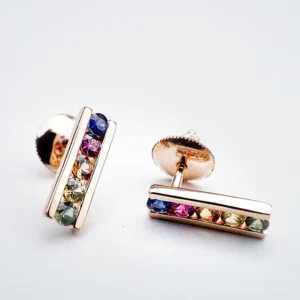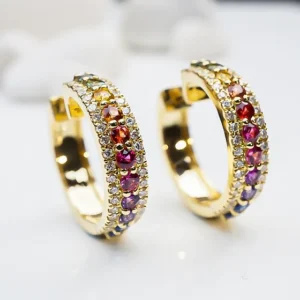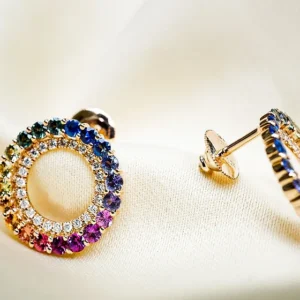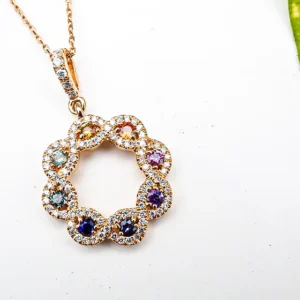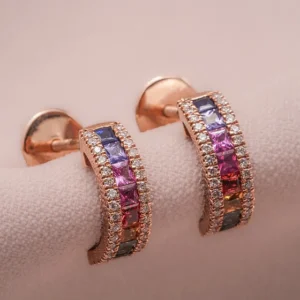Diamond Color: Unveiling the Spectrum of Brilliance
Diamonds, the exquisite gems that have captivated human hearts for centuries, owe much of their allure to their unique characteristics. One such characteristic that significantly influences a diamond’s appearance and value is its color.
Table of Contents
The subtle play of colors within a diamond can make the difference between an ordinary stone and a mesmerizing work of art. In this article, we’ll delve into the world of diamond color, exploring its significance, grading, and how it influences your diamond-buying decisions.
Introduction
Imagine a world without color, where everything is monotonous and lifeless. Now envision a world where every diamond showcases a unique spectrum of colors, captivating observers with its ethereal beauty. Diamond color adds depth and personality to these exquisite gems, turning each stone into a canvas of emotions, waiting to be cherished by those who behold them.
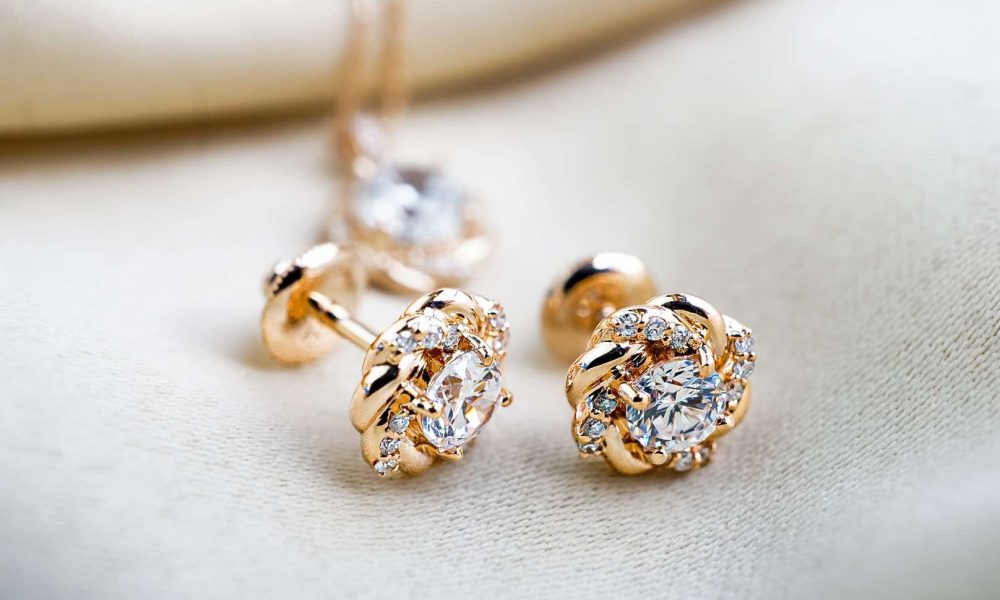
Dazzling Diamond Earrings
The Basics of Diamond Color
Diamond color refers to the presence of color or lack thereof within a diamond. While many diamonds appear colorless, they can actually exhibit subtle shades of color, often in the form of yellow or brown tints. The Gemological Institute of America (GIA) developed a standardized color grading scale to assess the extent of color in a diamond.
Diamond Color Scale
The diamond color scale or the GIA color grading scale ranges from D (colorless) to Z (light yellow or brown). Diamonds graded in the D-F range are considered truly colorless, exhibiting exceptional rarity and commanding higher prices. As you progress down the scale, the presence of color becomes more pronounced, influencing both the diamond’s appearance and value.
The Impact of Diamond Color on Value
Diamonds are a harmonious blend of beauty and rarity, with the latter often playing a pivotal role in determining their value. The quest for perfection in a diamond lies in its minimal color presence, or in other words, its colorlessness.
Such diamonds, graded in the D-F range on the standardized color grading scale, are exceedingly rare and, as a result, highly coveted. These gems occupy a premium position in the market, sought after by connoisseurs and collectors alike.
However, as the presence of color within a diamond becomes more pronounced, its value typically follows a diminishing trajectory. This dynamic reflects the delicate balance between rarity and beauty in the world of diamonds, where even the slightest hint of color can significantly influence the gem’s desirability and market positioning.
How Diamond Color Affects Appearance
Diamonds are celebrated for their brilliant ability to refract light, but color can hinder this optical performance by absorbing light and diminishing a diamond’s sparkle. Colorless diamonds, ranked at the top of the color grading scale, excel in reflecting light without hindrance, creating a dazzling display of fire and brilliance that captivates the eye.
Factors Affecting Diamond Color Perception
Perception of diamond color is a delicate interplay of light, environment, and individual vision. Lighting conditions and surroundings can significantly influence how a diamond’s color appears. For instance, a diamond may exhibit different hues under natural daylight, incandescent, or fluorescent lighting, leading to varied perceptions.
This dynamic interaction between light and environment adds complexity to the appreciation of diamond color, making it a captivating and ever-changing visual experience.
4 Cs of diamonds: Choosing the Right Diamond Color
While the 4 Cs (carat weight, cut, color, and clarity) are crucial in choosing a diamond, color remains a personal preference. Some prefer the timeless elegance of colorless diamonds (D-F range) for their pure, transparent appearance.
Others embrace the gentle warmth of slightly colored stones (G-J range), appreciating their inviting glow. The choice between these options becomes an intimate expression of individual taste and style.
The Fascinating World of Fancy Colored Diamonds
Beyond the traditional color spectrum lies a realm of fancy colored diamonds. These diamonds exhibit vibrant hues, including shades of blue, pink, yellow, and green. Unlike colorless diamonds, fancy colored diamonds derive their beauty from the intensity and distribution of their colors.
Among the enchanting array of diamond colors, the yellow diamond stands as a mesmerizing testament to nature’s artistry. A yellow diamond’s vibrant hue exudes warmth and energy, often reminiscent of a radiant burst of sunshine.
These diamonds, also known as canary diamonds, occupy a unique place on the diamond color scale, showcasing a spectrum that ranges from light pastel shades to intense canary yellows. Their presence in the diamond grading scale adds a captivating diversity to the world of gems, captivating those who seek a touch of sunny brilliance in their jewelry collection.
Pink diamonds, often regarded as one of the most captivating treasures of the earth, hold a special place in the realm of gemstones. Their allure lies not just in their stunning shades, ranging from delicate blush to deep magenta, but also in their rarity.
Pink diamonds are among the rarest of all diamond colors, and their scarcity is reflected in their prominent position on the diamond grading scale. Owning a pink diamond is akin to possessing a piece of nature’s artwork, a testament to the beauty that emerges when time, pressure, and elements interact.
While the traditional notion of diamonds revolves around colorless or vividly colored stones, brown diamonds have quietly carved a niche of their own. These diamonds, also referred to as champagne or cognac diamonds, exhibit a rich and earthy hue that evokes warmth and elegance.
Brown diamonds, though lower on the diamond color scale, carry their own unique appeal, often resembling the finest of chocolates. Their presence among the 4 Cs of diamonds showcases the diversity and depth of nature’s palette.

A Brilliant Diamond Ring
The Intricate Dance of Light and Color
A diamond’s brilliance is a captivating interplay of its three essential components: cut, clarity, and color. The cut, in particular, possesses the remarkable power to accentuate or temper the perception of a diamond’s color.
When a diamond is expertly cut, its facets are precisely aligned to maximize the reflection and refraction of light, creating a dazzling display that can enhance the perception of color. This means that even a diamond with a subtle hint of color can appear more vibrant and lively when its cut is executed to perfection.
Conversely, a poorly cut diamond can emphasize the presence of color, diminishing its overall appeal. In such cases, the facets may not align optimally, allowing light to escape without creating the desired play of brilliance, thus accentuating any color within the stone.
Therefore, the cut of a diamond becomes a vital orchestrator in the symphony of factors that contribute to its beauty and allure.
Tips for Selecting the Perfect Diamond Color
Selecting the perfect diamond color is a nuanced process that harmonizes personal preferences with informed choices. It’s a delicate balance of aesthetics and practicality. One crucial consideration is the metal color of the setting in which the diamond will be placed.
For instance, a white gold or platinum setting can enhance the brilliance of a colorless diamond, while a yellow gold setting may complement a slightly warmer-toned stone.
Additionally, the size of the diamond matters; larger diamonds tend to reveal color more prominently, making color grade selection significant. Of course, your budget plays a pivotal role, as higher color grades often come at a premium.
By thoughtfully weighing these factors, you can find a diamond that not only aligns with your visual preferences but also fits your budget and complements the overall aesthetic of your jewelry piece, ensuring that your choice is a reflection of both your style and practical considerations.
Unveiling the Secrets of Diamond Color Enhancement
Technology advancements allow for diamond color enhancement, broadening consumer options. However, these enhancements raise ethical and disclosure concerns. Transparency is vital, ensuring consumers receive accurate information about a diamond’s treatments.
Balancing technological progress, ethical practices, and consumer education is key to maintaining trust in the diamond industry.
Investing in Colored Diamonds: A Shrewd Choice?
As the demand for colored diamonds grows, they have become a potential investment avenue. While colorless diamonds have historically dominated the market, the allure of rare and captivating colored diamonds has led many investors to consider them as a unique asset class.
Love comes in various shades, just like diamonds. A yellow diamond ring signifies more than a dazzling piece of jewelry; it represents a unique expression of love and happiness. The yellow hue of these diamonds symbolizes joy and optimism, making them an ideal choice for celebrating life’s precious moments.
Their position on the diamond color scale adds an extra layer of significance, showcasing their exceptional brightness and charm. Whether as engagement rings or anniversary gifts, yellow diamond rings embody the radiance of love itself.
When it comes to expressing affection and elegance, few things can match the allure of a pink diamond ring. Pink diamonds, a rare subset within the diamond color spectrum, have captured hearts with their delicate and romantic shades.
These exquisite gems, often found in Australia’s Argyle mine, offer a remarkable display of femininity and charm. Their scarcity places them at a premium position in the diamond grading scale, making pink diamond rings not just a symbol of love, but also a testament to the beauty of rarity.
Caring for and Preserving the Beauty of Diamond Color
Owning a diamond is not just a privilege but also a responsibility to preserve its enduring beauty. Safeguarding the color and brilliance of your diamond requires simple yet essential care practices. Regularly cleaning your diamond, whether it’s in a ring, necklace, or any other jewelry piece, helps maintain its sparkle.
You can use a mild detergent and a soft brush to gently clean away dust and grime that may accumulate over time. Proper storage is equally crucial; consider keeping your diamond pieces in separate compartments or pouches to prevent them from scratching against other jewelry items.
Also, it’s essential to be mindful of potential hazards. Avoid exposing your diamond to harsh chemicals or abrasive materials that can erode its surface and diminish its radiance. By following these care guidelines, you can ensure that your diamond’s beauty continues to shine brightly for generations to come.
The Psychology of Diamond Color: What Does It Symbolize?
Colors hold immense psychological power, and diamonds’ hues are no exception. For example, a blue diamond conveys tranquility and strength, akin to a serene ocean. On the other hand, a yellow diamond symbolizes joy and optimism, much like the radiant warmth of the sun.
These colors go beyond aesthetics, becoming personal expressions of emotions and sentiments through cherished jewelry pieces.

Pearl Diamond Earrings
Months Birthstones and Diamond Color: A Personalized Connection
Months Birthstones have long held a special place in human culture believed to possess unique meanings and attributes that resonate with individuals born in each month. Diamonds, being the birthstone for April, align perfectly with the characteristics associated with this time of the year.
As the birthstone for the month, diamonds encapsulate strength, purity, and endurance – qualities often associated with the spring season’s renewal and vitality. While diamonds are often revered for their colorless brilliance, the world of colored diamonds offers an intriguing connection to birthstones.
Those born in April are fortunate to have diamonds as their birthstone, opening up a world of possibilities beyond the traditional clear gemstones. Alongside the dazzling array of colorless diamonds, individuals can explore the enchanting realm of pink diamonds and yellow diamonds, both of which beautifully complement the vibrant spirit of spring.
Each month’s birthstone is believed to carry unique energies and symbolism, making the connection between diamond color and birth month even more special. For those seeking a personalized touch, incorporating a birthstone diamond into jewelry, whether it’s a necklace, ring, or bracelet, adds a meaningful dimension that goes beyond aesthetics.
As you celebrate the month of your birth, consider the incredible variety that diamonds offer. From the classic elegance of colorless diamonds to the vivid allure of pink and yellow diamonds, these gems allow you to express your individuality and celebrate the essence of the month you were born in.
Birthstones: A Gem for Every Month
Gemstones have a captivating way of reflecting the essence of each month, encapsulating unique qualities that resonate with individuals born during that time. From January to December, each month boasts a specific birthstone that holds special significance. Let’s explore the enchanting world of birthstones and the stories they tell:
January Birthstone: Garnet - A Fiery Start to the Year
The January Birthstone, Garnet, is renowned for its deep red hues that symbolize passion, strength, and prosperity. These gemstones have a timeless allure and have been used in jewelry and ornaments for centuries. While red is the most common color, garnets can also be found in shades of green, orange, and even rare blue. Embrace the fiery spirit of the new year with this vibrant gem.
February Birthstone: Amethyst - A Royal Purple Elegance
The February Birthstone, Amethyst, is prized for its regal purple color that symbolizes peace, protection, and clarity of mind. Ranging from pale lilac to deep violet, amethyst has been associated with both royalty and spirituality throughout history. Its soothing energy makes it a popular choice for jewelry that promotes tranquility and balance.
March Birthstone: Aquamarine - Calm Waters and Serenity
The March Birthstone, Aquamarine, draws inspiration from the serene blue hues of the ocean. Its name translates to “water of the sea,” and it’s believed to bring a sense of calm, courage, and clarity to its wearer. Ranging from pale blue to intense teal, aquamarine evokes the tranquility of water and the promise of new beginnings.
April Birthstone: Diamond - Eternal Brilliance and Strength
The April Birthstone, Diamond, represents purity, eternal love, and unbreakable strength. These precious gems, renowned for their unparalleled brilliance, come in various colors, with the most valued being colorless. Diamonds symbolize endurance and commitment, making them a classic choice for engagement rings and cherished gifts.
May Birthstone: Emerald - Vibrant Green of Growth
The May Birthstone, Emerald, is a lush green gemstone that symbolizes renewal, growth, and vitality. Its rich color is associated with rebirth and fertility, making it a cherished choice for celebrating life’s milestones. Emeralds are said to bring harmony and balance, making them a captivating choice for jewelry that connects with nature’s beauty.
June Birthstone: Pearl and Alexandrite - Dual Birthstones of Elegance
The June Birthstone boasts not one, but two birthstones: Pearls and Alexandrite. Pearls, known for their timeless elegance, symbolize purity and wisdom. Their luminescence and soft glow make them a staple in both classic and modern jewelry.
Alexandrite, on the other hand, is a rare gem that changes color from green in daylight to red under incandescent light. This captivating shift symbolizes balance and inner strength.
July Birthstone: Ruby - Passionate Red Splendor
The July Birthstone, Ruby, exudes fiery passion and vitality with its vivid red color. Rubies are associated with love, courage, and protection, making them a cherished choice for expressing deep emotions. These gems are believed to bring good fortune and success to their wearers, making them a symbol of power and prosperity.
August Birthstone: Peridot - A Green Gem of Healing
The August Birthstone, Peridot, showcases a vibrant green hue that reflects the colors of nature. Known as the “gem of the sun,” peridot is believed to possess healing properties and is associated with prosperity, growth, and well-being. Its cheerful color and positive energy make it a popular choice for those seeking to embrace the joys of life.
September Birthstone: Sapphire - Blue Majesty and Wisdom
The September Birthstone, Sapphire, is renowned for its stunning blue hues that evoke wisdom, loyalty, and nobility. While blue sapphires are the most well-known, these gemstones can also be found in various colors, including pink, yellow, and even colorless. Sapphires are believed to bring clarity of thought and enhance spiritual insight.
October Birthstone: Opal and Tourmaline - Dynamic Birthstone Duo
The October Birthstone is graced by two birthstones: Opal and Tourmaline. Opal’s captivating play of colors symbolizes creativity and inspiration. Its ever-changing hues make it a gem that reflects individuality and imagination.
Tourmaline, available in a dazzling range of colors, is believed to promote balance, compassion, and protection. These birthstones offer a dynamic blend of aesthetics and symbolism.
November Birthstone: Topaz and Citrine - Golden Warmth and Joy
The November Birthstone also features two birthstones: Topaz and Citrine. Topaz, available in various colors, symbolizes strength and intellect. Its warm tones evoke a sense of coziness and contentment. Citrine, on the other hand, is a bright and cheerful gemstone that radiates joy and positivity. Together, these birthstones bring a touch of golden warmth to the autumn month.
December Birthstone: Turquoise, Tanzanite, and Zircon - Treasures of December
The December Birthstone is blessed with a trio of birthstones: Turquoise, Tanzanite, and Zircon. Turquoise is an ancient gemstone known for its vibrant blue-green color that symbolizes protection and good fortune.
Tanzanite, discovered relatively recently, captivates with its deep blue hues and is associated with spiritual growth and transformation. Zircon, available in a range of colors, is believed to bring peace and prosperity to its wearer.
Each birthstone holds a unique story and significance, making them cherished choices for personalized jewelry and meaningful gifts. Whether you’re drawn to the fiery red of a ruby or the tranquil blue of an aquamarine, birthstones offer a beautiful connection to the months they represent.

Diamond Pendant
Final Thoughts: Celebrating the Diversity of Diamond Color
As we draw the curtain on our exploration of the captivating realm of diamond color, it’s a celebration of the remarkable diversity and exquisite beauty that each shade bestows upon these precious gems.
The enchanting interplay of light and color is the magical essence that transforms diamonds into not just precious stones but timeless works of art. These gems, each unique in its spectrum of color, hold an enduring power to mesmerize and captivate.
They have, for centuries, been symbols of love, commitment, and enduring beauty, encapsulating emotions and stories that span generations.
As we cherish the vivid rainbow of diamond hues, we also acknowledge that beyond their physical beauty, diamonds carry with them the intangible, timeless allure that continues to leave us spellbound.
FAQs About Diamond Color
Feel free to explore these questions to gain a deeper understanding of diamond color and make informed decisions when selecting the perfect diamond for your needs and desires.
Yes, while D-F diamonds are considered truly colorless, diamonds in the G-H range also appear nearly colorless and are popular choices.
Fancy colored diamonds derive value from their rarity and intensity of color, making them equally valuable, if not more, in some cases.
No, a diamond's color is stable and doesn't change over time. However, it's essential to keep it clean and well-maintained to preserve its appearance.
Absolutely! Colored diamonds offer a unique and vibrant alternative to traditional colorless diamonds for engagement rings.
Black diamonds symbolize power, authority, and elegance, making them a distinctive choice for those seeking unconventional beauty.
The choice of diamond color often depends on personal preference and the desired appearance. If you're looking for a classic and brilliant look, opt for colorless or near-colorless diamonds in the D-F range. If you're drawn to warmth and character, consider diamonds in the G-J range, which offer a balance between color and value.
Naturally colored pink diamonds do exist and are exceptionally rare. These diamonds derive their color from unique geological conditions during formation. However, the majority of pink diamonds on the market are treated to enhance their color, making truly natural ones even more valuable and sought after.
Yes, beyond pink and yellow diamonds, the world of colored diamonds offers an array of stunning hues. Blue, green, red, and even black diamonds are examples of the diverse palette found in nature. These fancy colored diamonds are prized for their exceptional beauty and rarity.
Diamond color can certainly influence the value of antique or vintage jewelry, but it's not the sole determining factor. When evaluating antique pieces, consider the overall craftsmanship, historical significance, and the aesthetic appeal of the jewelry as a whole.
Absolutely! While diamonds are the traditional birthstone for April, those seeking vibrant alternatives can explore gemstones like white sapphire, zircon, and quartz. These gems come in an array of colors, allowing individuals to celebrate their birth month with a touch of personal flair.

